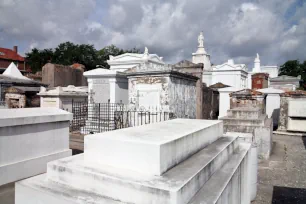St. Louis Cemetery No. 1 is a famous cemetery in New Orleans, situated just outside the French Quarter. It’s one of the most fascinating places in New Orleans, packed with old family tombs and statuary.

Due to the abundance of tombs and statuary, the cemeteries of New Orleans are one of the city’s most intriguing places to visit, so it’s no surprise that many tourists find their way to one of the many fascinating cemeteries that are spread all over the city. If you only plan to visit just one of them, then St. Louis Cemetery No. 1 near the French Quarter is a good choice.
The Cemetery



St. Louis Cemetery No. 1 opened in 1789 and is the oldest cemetery in New Orleans. It was established outside the city limits, since people believed that the presence of dead bodies in the city center caused diseases to spread. Due to the outbreak of yellow fever, it was already completely filled in 1829. Today on half its original size remains, and the cemetery is very much run-down; most tombs have fallen into disrepair. It hasn’t lost much of its charm, though, and there are many interesting stories behind the often dilapidated tombs.
Buried above-ground
The first French settlers buried their dead under the ground, but it soon became clear that was not such a great idea. Each time the city was flooded, coffins and bodies started to float to the surface of the wet earth. They soon decided to bury the dead in above-ground crypts, a practice that was already quite common in Europe.
This not only protected the coffins from getting flooded, but it also allowed the reuse of the vaults. Many of the crypts built were large family tombs where coffins were stacked several levels high. When a family ran out of space, the remains of the oldest coffin would be placed at the bottom of the tomb.


Notable Tombs
Some of the most illustrious citizens of New Orleans were buried here. The most famous is probably Voodoo queen Marie Laveau, whose resting place in a family tomb marked with the names Glapion, Laveau and Paris attracts plenty of visitors. Her tomb is often desecrated by people who mark a cross on her grave, supposedly this will make her spirit grant a wish. (Please do not do this, living members of her family consider this vandalism). Despite a plaque which identifies the tomb as that of Laveau, it isn’t even certain she is buried there.
Other famous dead people in the St Louis Cemetery No. 1 include Benjamin Henry Latrobe, an architect who came to New Orleans to build waterworks but died from yellow fever. Another notable figure buried here is Jean Etienne Boré, the first post-colonial mayor of New Orleans. The first black mayor of New Orleans, Ernest ‘Dutch’ Morial is one of the more recent figures resting here. His family tomb is right near that of Marie Laveau. Homer Plessy, who challenged segregation laws, rests here as well. A large bronze plaque on his tomb commemorates the so-called Plessy v. Ferguson case, which resulted in the US Supreme Court actually confirming segregation in 1896. Some colorful figures in New Orleans’ history, such as Paul Morphy, a chess prodigy from the nineteenth century who became unofficial world champion at the age of 21 and Bernard de Marigny, who inherited a fortune at the age of 15. He introduced the dice game craps in New Orleans and developed the Marigny neighborhood.
The tallest monument in the St. Louis No. 1 cemetery is the Italian Mutual Benevolent Society tomb. It was common for immigrants in New Orleans to pool funds to lower the burial costs for individuals. The tomb has space for more than a thousand remains. It formed the background in a disturbing scene in Easy Rider. According to local legend, a statue known as ‘Charity’ was vandalized by Dennis Hopper, who supposedly tore the head off the statue.

Visiting the cemetery
You are free to wander around the walled-in cemetery on your own, but it might be a good idea to join one of the organized walking tours that are scheduled on a regular basis. Not only will this help you identify the most interesting tombs and learn the stories behind them, it will also be a safer experience. The old cemeteries are known to be unsafe, especially when you’re on your own. The largest monument in the cemetery was also built by a benevolent society, the “Société Française de Bienfaisance”. It contains some seventy vaults.

